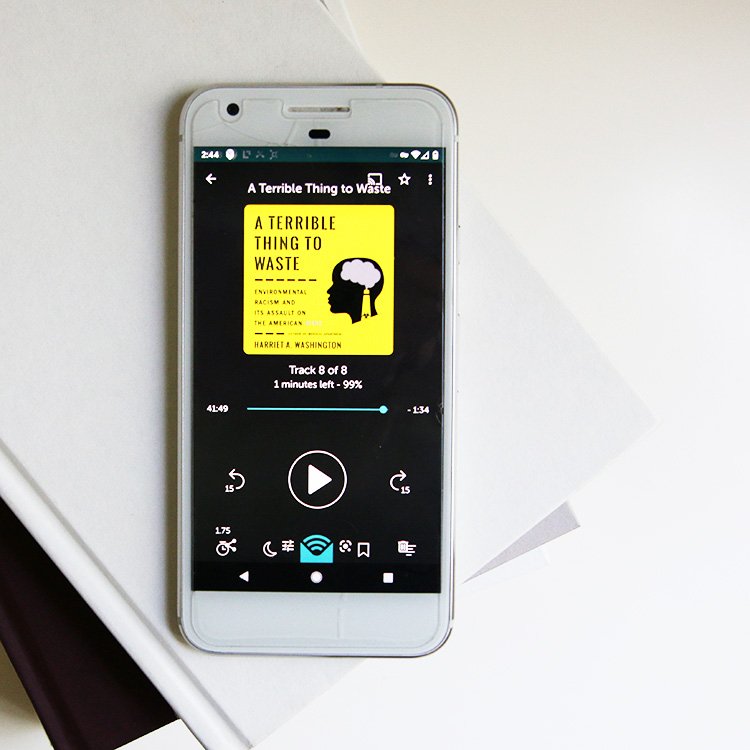Environmental Racism | A Terrible Thing To Waste Book Review
Environmental advocacy and racial advocacy are deeply intertwined. While both push for change to enhance the well-being of people on this planet, environmental hazards and climate change disproportionately harm Black and Brown people.
A Terrible Thing To Waste: Environmental Racism and It’s Assault on American Minds lays out in detail the damage and trauma endured by Americans, and especially Black and Brown people, as a result of careless and sometimes intentionally reckless destruction of our planet and our communities perpetuated and facilitated by corporations, our government, and the people who run them.

I am a member of the Burning Issue Book Club led by Renate Boronowsky of Renate Bakes. Each month, we read a book about environmental and/or social justice issues and share thoughts or reflections in a Facebook group. Prior to quarantine, they also met up in person in Long Beach California, and now they meet via video chat once a month to discuss the book and share supporting resources.
For May, we read A Terrible Thing To Waste: Environmental Racism and It’s Assault on American Minds. In the book, the author, Harriett A Washington, chronicles the plethora or poisons, toxins, and other pollutants present in water, soil, air, and the many products we use in daily life. She argues that these chemicals and toxic substances to which we are exposed cause significant intellectual and developmental damage to everyone and especially to children.
According to Washington’s research, exposure to toxic chemicals and pollution directly contributes to lower IQ scores. Scientific studies have shown that even minimal amounts of exposure to chemicals like lead and mercury reduce the brain’s ability to develop, grow, and learn at its highest capability. The effects of these toxins are particularly acute on the brains of fetuses and young children.
More troubling, communities of color are disproportionately situated near toxic sites, among dirty air, and on polluted soil. Thus, these communities are especially harmed by the onslaught of damage environmental hazards cause, and the loss of intellectual abilities (or IQ points, as she says) plagues communities of color in ways far beyond initial exposure. Further, due to structurally racist systems like mortgage redlining and other housing discrimination, among other reasons, people of color have few opportunities to move away from these polluted communities laden with toxins and chemicals.
The book is dense and includes extensive examples of industry and government turning a blind eye toward, or sometimes even encouraging, the destruction of communities and human health for the benefit of corporate profits, preservation of reputations, and protection of white people. She chronicles examples of the past as well as tragedies continuing to plague us today.
IQ Disparities A Result of Environmental Racism
Further, Washington explains that environmental racism, or environmental harm caused disproportionately to non-whites, should be considered as one factor against any claims that IQ disparities are genetic and indicative of racial superiority. At times, IQ differences have been used to substantiate and perpetuate racism.
To perpetuate and validate the unfair biases about genetic racial disparities in IQ, some highly-acclaimed scientists with specialties outside of genetics have made verbal claims and written extensive texts on their supposed scientific opinions that IQ is driven and determined by race and heredity. This is terribly flawed.
Even a well-deserved Nobel prize in physics, for example, does not warrant someone to be trusted with complex scientific analysis related to genetics. Yet because some of these scientists have been so successful in their own fields, many believe their expertise transcends very different types of science and use their flawed analysis to uphold unearned white supremacy, power, privilege.
Near-Term and Long-Term Solutions For Environmental Racism
Washington closes out the book with two chapters on actions we can take today to reduce the impact of toxins and pollutants on humanity and clean up our communities for the future. While the near-term steps don’t solve the solutions that will take decades, at best, to resolve, they offer a dollop of hope for the present and future.
She also calls upon all of us to be more active in our communities and speak up for the planet and those most afflicted by environmental racism.
Environmentalism and social justice are closely tied. Both strive for the protection of basic human rights and the well-being of everyone on this planet. How much can humanity thrive on a clean planet if it’s not a place for everyone to live healthy and prosperous lives?
This book is necessary reading for all of us. It’s not easy reading, and at times, I felt a little hopeless. How can we change so much institutionalized apathy for the planet and the people who live on it, especially our neighbors of color? But by doing nothing, we know that’s a quick way to lose everything. We must do something, and this book is a great first step toward understanding how our systems are so broken and what we need to change to pursue intersectional environmentalism.






![12 Engaging Earth Day Activities and Event For Kids [2021]](https://www.honestlymodern.com/wp-content/uploads/2020/08/Hiking-With-Boys-How-To-Help-Kids-Explore-Nature-1.jpg)
